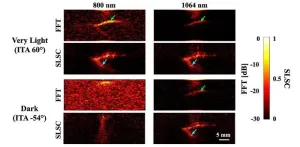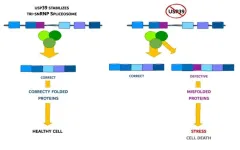(Press-News.org) It’s well documented that firefighters have significantly higher rates of cancer than the general population, and these elevated rates have been associated with exposures to toxic chemicals on the job. However, most research on cancer in firefighters has been done in men and less is known about the risks in women.
Now a new study by Silent Spring Institute has identified multiple chemical exposures that firefighters face on the job that could increase their risk of developing breast cancer.
“With more and more women entering the profession, it’s important to understand the impact of workplace exposures on their health so that we can inform policies to reduce exposures and create a safer work environment,” says study-co-author Ruthann Rudel, director of research at Silent Spring Institute.
The study appears in the journal Toxics as part of a special issue on firefighters’ occupational exposures and health risks.
Rudel and her colleagues searched through databases from the International Agency for Research on Cancer (IARC) and the U.S. National Toxicology Program to identify chemicals that cause mammary tumors in animals, because these chemicals are likely to increase breast cancer risk. In addition, the team searched for chemicals that have been associated with breast cancer in human studies.
The researchers then identified more than a hundred studies that describe the different chemicals firefighters encounter on the job and screened these studies to see which of these workplace exposures also raise the risk of breast cancer.
The analysis revealed 12 chemicals or classes of chemicals that firefighters are highly exposed to on the job and are associated with breast cancer risk. The chemicals include benzene, PAHs, acetaldehyde, styrene, dioxins, flame retardants, PFAS, and PCBs among others.
Firefighters can be exposed to an array of toxic chemicals when putting out fires—building fires, wildfires, and vehicle fires. They also encounter harmful substances in their protective gear, fire station air and dust, and diesel exhaust from firefighter trucks.
Several years ago, Rudel and her collaborators in California published a study in which they found female firefighters in San Francisco have higher blood levels of cancer-causing PFAS than women working in downtown San Francisco offices. The researchers also found female firefighters have much higher levels of flame retardants, which are also carcinogenic, in their bodies.
Manufacturers add PFAS to firefighter turnout gear and firefighting foams. “But we don’t know where the flame retardants are coming from—they could be coming from the gear or another source,” says Rudel. “If it turns out the chemicals are being added to turnout gear, that would be important to know so that they can be replaced with safer alternatives.”
Similarly, diesel exhaust from fire trucks contains PAHs, so switching to electric trucks would help lower exposures as well, she says. “It’s important to look at all the equipment and materials that firefighters routinely use.”
Understanding the risks women face on the job can not only help change policies to improve worker safety, but also it could help ensure female workers receive the medical care and other benefits they need should they develop breast cancer.
“This study fills an important research gap by underscoring the unique health risks female firefighters face from occupational exposures to toxic chemicals, specifically chemicals linked with breast cancer,” says Dr. Dan Whu, Chief Medical Officer at the International Association of Fire Fighters (IAFF).
According to the IAFF, 20 states currently have presumptive laws that specify breast cancer as an occupational illness. This entitles firefighters to workers' compensation, disability, medical leave, and medical expense coverage if they are diagnosed with the disease. Another 16 other states have laws with less specific language that could allow the inclusion of breast cancer. On the other hand, at the federal level, the current cancer presumptive legislation does not include breast cancer.
“That means there are a lot of places in the country where female firefighters are not protected,” says Rudel. “Hopefully, the findings from our study will change that.”
Funding for this work came from the California Breast Cancer Research Program Grants #19UB-2900 and # 23BB-1700 and Silent Spring Institute’s Safer Chemicals Program, which is funded by charitable gifts.
Reference: Cardona B., K.M. Rodgers K.M., J. Trowbridge, H.B. Buren, R.A. Rudel. 2024. Breast Cancer-Related Chemical Exposures in Firefighters. Toxics. 12(10):707. DOI: 10.3390/toxics12100707
About Silent Spring Institute: Silent Spring Institute, located in Newton, Mass., is the leading scientific research organization dedicated to uncovering the link between chemicals in our everyday environments and women's health, with a focus on breast cancer prevention. Founded in 1994, the institute is developing innovative tools to accelerate the transition to safer chemicals, while translating its science into policies that protect health. Visit us at www.silentspring.org.
END
Firefighters exposed to chemicals linked with breast cancer
Study identifies 12 toxic chemicals that put female firefighters at increased risk for the disease
2024-11-14
ELSE PRESS RELEASES FROM THIS DATE:
Addressing the rural mental health crisis via telehealth
2024-11-14
The Medical University of South Carolina has been awarded $1.75 million from the Health Resources and Services Administration to develop and test the effectiveness and sustainability of the SC Rural Telehealth-enabled Collaborative Care Network (SC-RTECC). The SC-RTECC will deliver psychiatric collaborative care management to 1500 primary care patients over a five-year period in seven diverse, rural, underserved South Carolina counties.
The goal of the project is to test whether telehealth can be used to deliver psychiatric collaborative care management efficiently and sustainably at rural primary care clinics in South Carolina.
The project will be led by Ryan ...
Standardized autism screening during pediatric well visits identified more, younger children with high likelihood for autism diagnosis
2024-11-14
New research from Drexel University’s A.J. Drexel Autism Institute found that the use of standardized autism screening during pediatric well-child visits identifies more children with high autism likelihood at a younger age, including those presenting with more subtle symptoms. This is the first large-scale, randomized trial to test the impact of standardized autism screening on early detection of autism in pediatric primary care.
Recently published in the Journal of the American Academy of Child & Adolescent Psychology, the multi-site ...
Researchers shed light on skin tone bias in breast cancer imaging
2024-11-14
Breast cancer is a major health concern worldwide, and early detection is crucial for effective treatment. Traditional imaging methods, such as mammography, have limitations, especially for women with dense breast tissue. Photoacoustic imaging, which combines light and sound to create detailed images of breast tissue, offers a promising alternative. However, recent research has highlighted a significant challenge: skin tone bias.
A team of researchers from Johns Hopkins University recently investigated how skin tone affects the visibility of breast cancer targets in photoacoustic imaging. As reported in Biophotonics Discovery, the study focused on three image ...
Study finds humidity diminishes daytime cooling gains in urban green spaces
2024-11-14
Urban green spaces provide shade for city dwellers facing rising temperatures brought on by climate change, but how much relief from the heat island effect do they provide when humidity is factored in?
The temperature and humidity effect cancel each other out during daylight hours, but green spaces provide a net reduction in humid heat at night, according to a new study in Nature Cities, co-authored by Yale School of the Environment doctoral student Yichen Yang and Xuhui Lee, Sara Shallenberger Brown Professor of Climate Science.
"When it comes to urban ...
Tennessee RiverLine secures $500,000 Appalachian Regional Commission Grant for river experience planning and design standards
2024-11-14
The Tennessee RiverLine, an initiative of University of Tennessee Extension, has been awarded a $500,000 Area Development grant from the Appalachian Regional Commission (ARC) and Tennessee Department of Economic and Community Development to support the development of comprehensive Planning and Design Standards. These standards will help accelerate the creation of new river experience amenities along the 652-mile stretch of the Tennessee River, benefitting residents and visitors throughout the region.
The 18-month project will be led by a professional ...
AI tool ‘sees’ cancer gene signatures in biopsy images
2024-11-14
To determine the type and severity of a cancer, pathologists typically analyze thin slices of a tumor biopsy under a microscope. But to figure out what genomic changes are driving the tumor’s growth — information that can guide how it is treated — scientists must perform genetic sequencing of the RNA isolated from the tumor, a process that can take weeks and costs thousands of dollars.
Now, Stanford Medicine researchers have developed an artificial intelligence-powered computational program that can predict the activity of thousands of genes within tumor cells based only on standard microscopy images of the biopsy. The tool, described online in Nature Communications Nov. 14, ...
Answer ALS releases world's largest ALS patient-based iPSC and bio data repository
2024-11-14
Answer ALS Releases World's Largest ALS Patient-Based iPSC and Bio Data Repository
Unprecedented resource, created with Cedars-Sinai, to accelerate ALS research and drive development of targeted therapies globally
NEW ORLEANS, [November 14, 2024] — In a landmark continuing collaboration, Answer ALS and Cedars-Sinai have announced the completed availability of the largest amyotrophic lateral sclerosis (ALS) patient-based induced pluripotent stem cell (iPSC) and bio data repository. The repository encompasses biological and clinical data from nearly 1,000 ALS patients, offering an unprecedented resource for global ...
2024 Joseph A. Johnson Award Goes to Johns Hopkins University Assistant Professor Danielle Speller
2024-11-14
WASHINGTON, Nov. 14, 2024 – AIP and the National Society of Black Physicists congratulate Danielle Speller as the winner of the 2024 Joseph A. Johnson Award for Excellence. Jessica Esquivel is also being recognized with an Honorable Mention.
The Johnson Award, now in its fifth year, is given jointly by AIP and NSBP to recognize early-career scientists who demonstrate scientific ingenuity and impactful mentorship and service—the core values of NSBP founder Joseph A. Johnson.
“Dr. Speller not only ...
Slow editing of protein blueprints leads to cell death
2024-11-14
FRANKFURT. Genes contain the essential building instructions for life, guiding cells on which amino acids to assemble in what sequence to produce specific proteins. The human genome codes for about 20,000 such instructions. “Nevertheless, our cells can produce several hundred thousand different proteins,” explains Prof. Ivan Đikić from the Institute of Biochemistry II at Goethe University Frankfurt.
This diversity is enabled by a process known as “splicing.” When a cell requires a protein, it generates a copy of the relevant instructions in the cell nucleus. During splicing, this transcript undergoes modification: a cellular editing complex, the spliceosome, ...
Industrial air pollution triggers ice formation in clouds, reducing cloud cover and boosting snowfall
2024-11-14
Pollution from industrial hotspots can trigger ice formation in supercooled clouds, altering their reflective properties and increasing regional snowfall, according to a new study. The findings shed light on poorly understood impacts of anthropogenic aerosols on climate and could help improve climate modeling and mitigation strategies. The impact of human-generated aerosols (tiny air pollution particles) on climate, particularly in counteracting greenhouse gas-induced warming, remains uncertain. These aerosols, in addition to influencing cloud formation as cloud condensation nuclei (CCN), may also act as ice-nucleating particles (INPs), crucial for ice formation in supercooled ...
LAST 30 PRESS RELEASES:
Post-stroke injection protects the brain in preclinical study
Cardiovascular risk score predicts multiple eye diseases
Health: estimated one in ten British adults used or interested in GLP-1 medications for weight loss
Exercise to treat depression yields similar results to therapy
Whooping cough vaccination for pregnant women strengthens babies’ immune system
Dramatic decline in new cases of orphanhood in Uganda driven by HIV treatment and prevention programs
Stopping weight loss drugs linked to weight regain and reversal of heart health markers
Higher intake of food preservatives linked to increased cancer risk
Mass General Brigham–developed cholera vaccine completes phase 1 trial
First experimental validation of a “150-year-old chemical common sense” direct visualization of the molecular structural changes in the ultrafast anthracene [4+4] photocycloaddition reaction
Lack of support for people on weight loss drugs leaves them vulnerable to nutritional deficiencies, say experts
Dogs’ dinners can have greater climate impact than owners’
Are you ready to swap salmon for sprats and sardines?
1.6 million UK adults used weight loss drugs in past year
American College of Cardiology comments on new dietary guidelines for Americans
American Society of Gene & Cell Therapy and Orphan Therapeutics Accelerator partner to advance and commercialize promising rare disease treatments
One in 14 patients having day case surgery have new or worse chronic pain 3 months after their operation
New study highlights link between eviction rates and gun violence
Heatwaves heat up soil but not toxin levels in rice, study finds
Digital modeling reveals where construction carbon emissions really come from
Turning farm waste into water filters
New study shows how the spleen helps the immune system accept a transplant
New Mayo Clinic study advances personalized prostate cancer education with an EHR-integrated AI agent
Researchers identify novel therapeutic target to improve recovery after nerve injury
Microbes in breast milk help populate infant gut microbiomes
Reprogramming immunity to rewrite the story of Type 1 diabetes
New tool narrows the search for ideal material structures
Artificial saliva containing sugarcane protein helps protect the teeth of patients with head and neck cancer
Understanding the role of linear ubiquitination in T-tubule biogenesis
Researchers identify urban atmosphere as primary reservoir of microplastics
[Press-News.org] Firefighters exposed to chemicals linked with breast cancerStudy identifies 12 toxic chemicals that put female firefighters at increased risk for the disease







